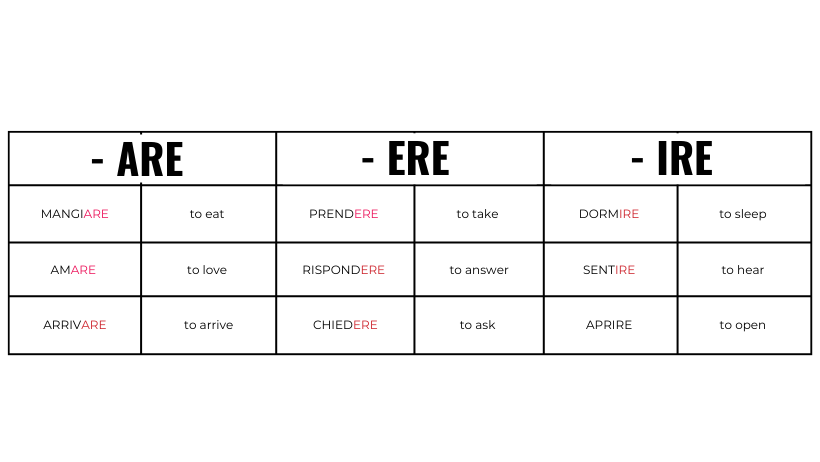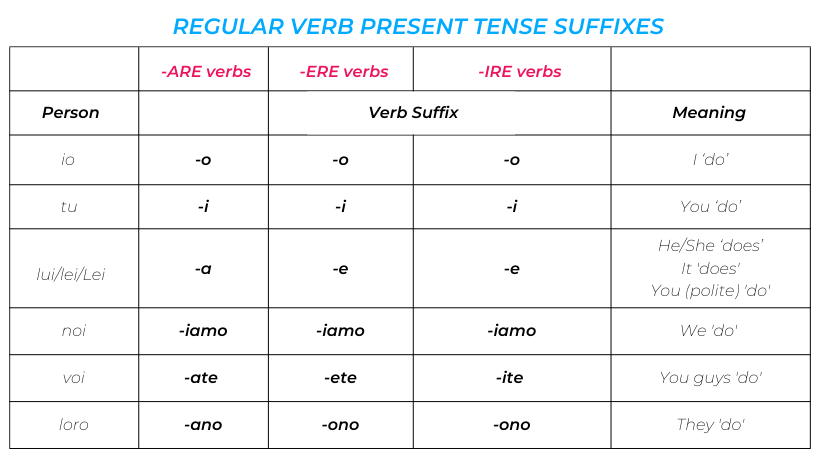Using verbs correctly in Italian is one of the main challenges for English speakers when they first start learning Italian. This is due to the fact that Italian has quite an extensive system of verb conjugation. This frightens a lot of English speakers as it all seems so complicated and hard to remember, but it is actually very systematic and follows a (mostly) consistent pattern.
Conjugation is when you change the form of the ending the verb, to refer to a particular Subject that is the ‘doer’ of the verb. English now uses an extremely limited system of conjugation that in the Present Tense only affects the 3rd Person Singular – he, she, it – by adding an -s to the end of the verb:
He eats, She runs, It sounds
English verbs for every other person all take the same form in the Present Tense:
I eat, you eat, we eat, they eat…
This is why English has to use Pronouns to mark the Subject, otherwise you wouldn’t know who is doing what. Italian, on the other hand, does not have to use Pronouns as the information about who is doing the action is all contained within the verb.
Italian Verbs are categorized into three main grammatical categories based on their pattern of conjugation – that is, the set of verb endings they take for different Subjects.
The three categories are:
???? -ARE verbs
???? -ERE verbs
???? -IRE verbs
The names of the verb categories come from the form the verb takes in the Infinitive – that’s the equivalent of the TO + VERB form in English.
The -ARE, -ERE and -IRE endings are known as a Suffix and are the part of the verb that is “removed” and replaced with another ending to indicate a certain Subject. The main part of the verb that never changes is known as the Root and this carries the basic meaning of the verb itself, like ‘do’, ‘eat’, and ‘go’.
Here are some examples of common verbs for each verb category. The underlined part of the verb is the Root that carries the base verbal meaning and the ending in bold is the Infinitive Suffix that gets replaced with different Suffixes to mark different Subjects.

Verb Conjugation in the Present Tense
So, now we know the verb categories and the Infinitive form of verbs, let’s look at how verbs actually conjugate in Italian. These are the Present Tense Suffixes for all regular verbs in each category. They are the endings that you “attach” to the Root of any regular verb to indicate Person (who), Number (Singular or Plural), and Tense, in the same way that you attach an -s to a verb Root in English to mark 3rd Person Singular Present.

Can you see a pattern here?
The conjugation takes exactly the same form across all three verb types for 1st Person Singular (IO), 2nd Person Singular (TU), and 1st Person Plural (NOI). That makes things much easier as it’s only one Suffix you need to remember for each Person.
Anytime you want to say:
◉ ‘I do X’, you end the verb with -o
◉ ‘You do X’, you end the verb with -i
◉ ‘We do X’, you end the verb with -iamo
The Suffixes for the other Persons only vary slightly between the verb types:
◉ 3rd Person Singular (LUI/LEI) ends in a vowel: -a for -ARE verbs and -e for both -ERE and -IRE verbs.
◉ 2nd Person Plural (VOI) uses an -A/-E/-I + -TE construction
◉ 3rd Person Plural (LORO) uses a -A/-O +-NO construction
Learning the meaning of these Suffixes will not only allow you to construct your own meaningful verbs, but it will also allow you to gain a better understanding of what is being said. For example, if you hear a verb that you don’t know, such as USCIAMO, you may not know the meaning of the verb itself, but the presence of the -IAMO Suffix will indicate that they are saying ‘we do something’, and then you can rely on context to fill in the blanks.
Now that we know the meaningful bits to add to verb Roots, you’re ready to start looking at the conjugation of some regular verbs that you will commonly encounter and need to use in your daily life.

